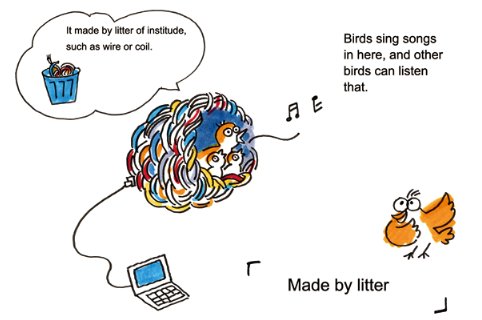| Many things have come together in the design of this birdhouse.
First I was interested in how birds actually make nests. How do they manage to construct a structure that holds up? What determines the size and shape of the birdhouse? How do they start? So I studied literature on birdhouses (in particular Hansell,2000) and was particularly inspired by the "village weaver" (Plocens cucullatus) and "northern Oriole" (Icterus galbula). It turns out that birds use a set of repeated stereotyped movements and simple building rules together with careful selection of materials.
The complexity of the nest arises from these simple principles. This is a topic which greatly interests me and which inspires a lot of research into artificial life.I mimicked in the construction of my nest some of these principles. I also used the kinds of stitches birds use, like spiral coils, weaves, alternately reversed winding, etc.
Second I wanted to use left over materials from my own laboratory, inspired by the idea to reuse waste for new purposes. I saw birds on the canals in Amsterdam who use plastic and wires that they found on the streets. My laboratory is full of wires and other components we use to build robots. So this is where all the material for my bird nest has come from. I just went around in the laboratory (like a bird searching for material), took some piece of wire and inserted it the way a bird would do in the nest. An 8 year old child (Ezra Belgrado) helped me so that I would also see the nest and how it was shaping up from the viewpoint of the child.
Third I wanted to use sound in the birdnest, and they naturally had to come from birds. I looked at bird song and discovered very interesting work (such as by Nottebohm and his group in New York) on how bird song is changing every season and how the brains of birds grow and shrink to cope with the invention and learning of new bird songs. My own research on the origins of speech sounds is strongly related to this research. To make a link to this, I searched for a CD rom with birdsounds and found a good one that gives the bird songs in French (Parisian) gardens. It also explains in French what the songs are.
Finally, I wanted to make links to other birdnests through the Internet.
A little screen is to be inserted at the bottom of the nest and I propose to use images from webcams on the internet that are oriented towards birdnests. There are actually a lot of them all over the world! In fact it is amazing how many websites exist today that discuss birdnests. Through these images, we connect the birdnest with many other birdnests in the world and show nature as a world wide phenomenon. Children could also search on the net to find nice birdnest webcams which could then be displayed in my birdnest.
Reference:Hansell, M. (2000) Bird nests and Construction Behaviours.
Cambridge University Press, Cambridge UK. | |



